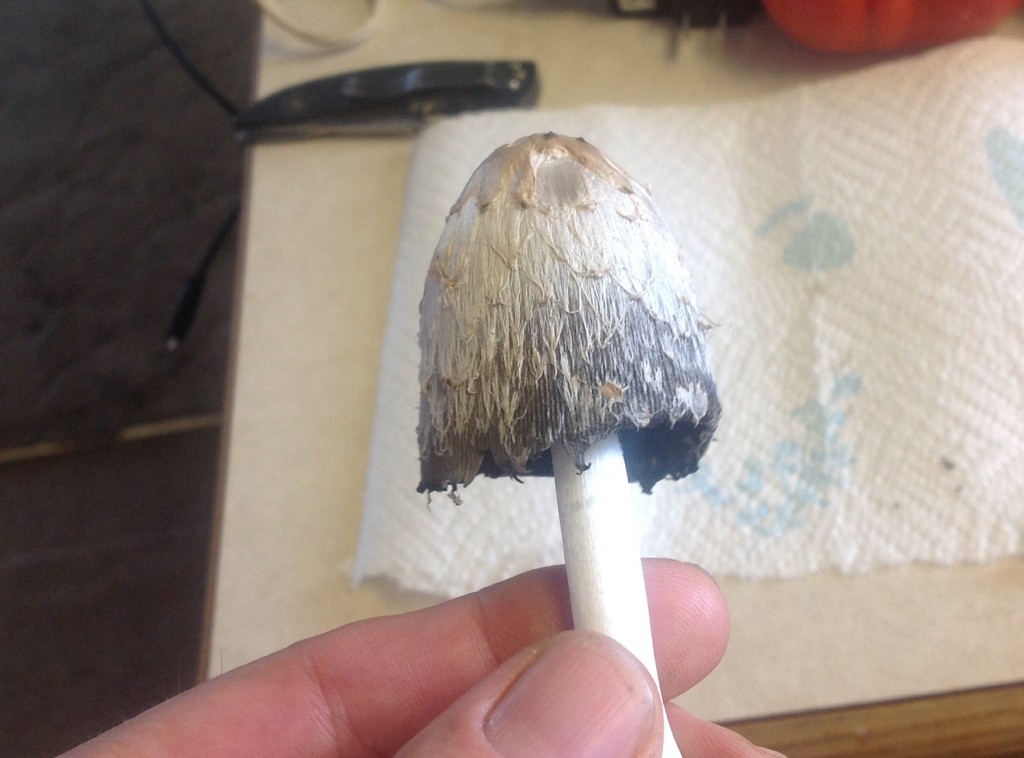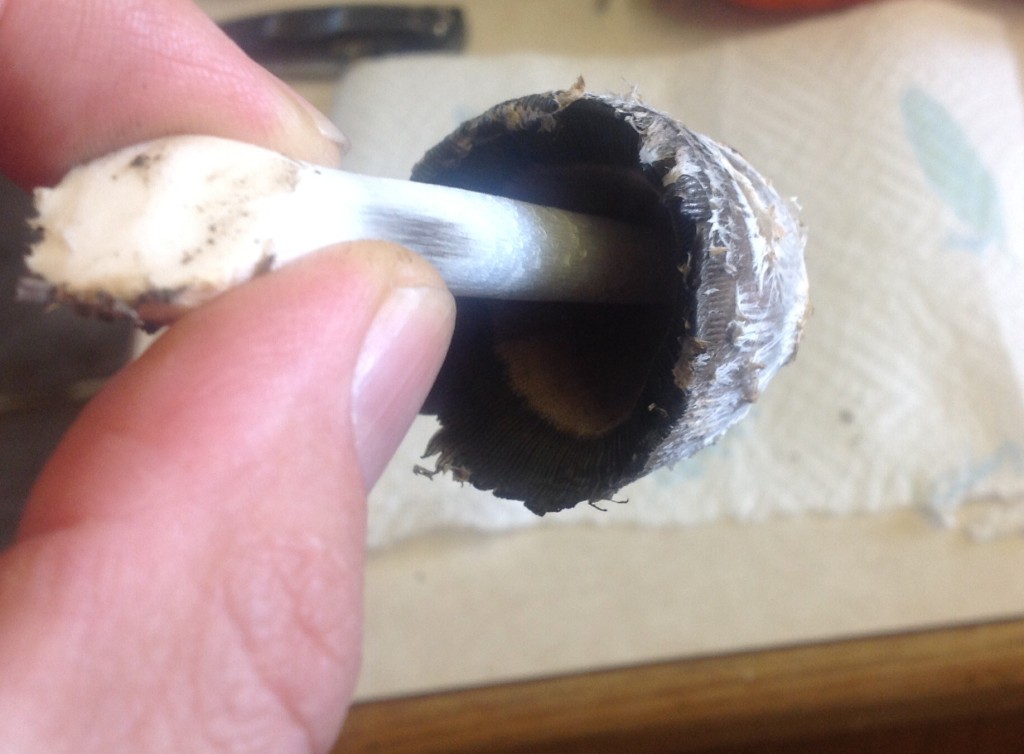Now that we’ve gotten a little rain, the wild mushrooms are coming out in force. Shaggy Manes aren’t common at my place, but they’re common enough you might want to know about them. They’re another edible mushroom likely to be found on laws and other locations similar to the habitat for the Meadow Mushrooms we’ve been using, or on roadsides in the back country. It’s called the Shaggy Mane for obvious reason. I found this one, solitary, on my lawn about fifteen yards from a nice fruiting of Meadow Mushrooms this afternoon. You’ll find them singularly, or in small groups.
This one is fairly small. They can be twice that size. Note the tall cap hanging down from its attachment point at the top inside of the cap, and the color fringe on the gills, which turn darker with age, and eventually melt into a black liquid. These are fragile mushrooms.
They’re not as good eating as the Meadow Mushrooms, but they’re more than OK, and they’re easy to identify. They don’t store well, so use them up in a day or two. Don’t over-cook or else they become watery.
See if you can find some. They’re not as easy to spot because of their camouflage-like appearance among the fall leaves. Here’s some more information.



Back in the 1970s at my small southern college, a visiting Chemistry professor who claimed expertise in wild mushrooms decided to show off his skill to his hosts, the Chem faculty, by collecting enough wild mushrooms for everyone to sample his gourmet cooking at the dinner given in his honor at the Department Chairman’s home.
Dismayed when the faculty demurred, he alone tried his mix of supposedly safe mushrooms. He alone, driven by the Chairman, had to go almost immediately to the emergency room for stomach pumping and a night of observation when the one or two mistakenly chosen poisonous ‘shrooms got to him. His lecture the next day to us students was preceded by a humble explanation of the event and a grateful thank-you to his hosts for their quick response to his illness.
He was an actual expert on mushrooms – for his locale in Washington State. In South Carolina, there were some look-alike poisonous varieties he could not differentiate from his hometown favorites.
I’ve kept that in mind ever since, and haven’t trusted anyone else to pick wild mushrooms for me, ever.
Yeah, when you’re picking a few, it’s easy to inspect each one. When picking a lot, not so much. That said, the Meadow Mushroom and the Shaggy Mane are two of the most easily identified. Morels (which are highly prized) verses False Morels (which can be dangerous) is another easy distinction, although they can be present in the same environments.
There is a species of white mushroom that grows in the same habitat as the white Meadow Mushroom here in the Northwest. They look virtually identical, except the Meadow Mushroom has light salmon to dark brown gills, and the other, which I believe to be a species of Amanita (possibly deadly), has pure white gills. There are other identifiers, such as staining when bruised and aroma, and then there is the identification of spores under a microscope and others, so it is at the same time necessary and quite possible to be sure.
I learned about mushrooms in Holland, and yes, extrapolating to other regions is potentially troublesome. The textbook I used was very good; it went out of its way to mention which edible mushrooms have no dangerous mimics (like boletes) and which ones do (like meadow mushrooms, and yes, the mimic is an amanita).
I still have the Dutch science magazine issue about amanita biochemistry (including muscaria). Fascinating — some of the poisons are cyclic proteins. And one of those oddball proteins is actually an antidote — but in far too low concentration to be helpful if you eat the thing.
I eat what I find in my home area. I like the Meadow Mushrooms. It’s a treat when they appear. I’m accustomed with a few local species by decades of use, and know them like you would know an apple from a tomato on the grocery store shelves (both round-ish and red, so one “mimics” the other). The white Amanitas look very similar until you look at the gills, after which there can be no mistake, although I’m beginning to notice that they have a different shade of white, even seen from the top, and the Amanitas tend to have a more uniformly round cap.
I am not concerned in the least, so long as I’m the one doing the picking and preparation. A toddler, for example, might mistake an apple for a tomato, but to suggest that you would make that mistake after having eaten both all your life (and probably picked both) would be laughable. Same deal.
Another very easily identified mushroom is the entire genera of Morels, that is if you know the easy distinction of Morel v. False Morel, as I said. I had some Morels growing in association with an apple tree, something I’d never heard of. They were not in the books, but I enjoyed them year after year until I moved from that property.
My wife would never eat them, despite my total lack of dying from them. She has the disease, the Food Fear, which is a virulent, communicable disease spread through Progressive media;
“Top then foods you should avoid at all costs!!!!”
“What the food companies don’t want you to know!!!” et al, ad infinitum.
But wait; you’re practicing food fear. It paralyses us to a degree. Everything comes with risks, and we learn to deal with them intelligently. Driving down a highway with opposing traffic mere feet away is far more dangerous than collecting wild food, and we take that in stride.
Don’t fall for the food fear scams.
I get what you’re saying about avoiding all risk, but at the same time there’s necessary and unnecessary risk. When there’s so much other food available, including wild, that doesn’t stand nearly the chance of leading to a slow painful death, I kinda see it as unnecessary. Almost like taking short cuts through dark alleys in bad neighborhoods. Yeah you can do it, but why? Basically I just don’t just myself enough to not screw up picking mushrooms…..
And yet it could be argued that knowing something about wild foods is an asset, a strength. In my way of thinking it goes along with getting experience in hunting (also totally “unnecessary”) and being able to grow a garden and store the food from it. Home canning, drying, and pickling come with certain risks too, as does eating food someone else grew, picked, and preserved as a business.
I have collected shaggy manes for years, in WI and MN. There’s nothing poisonous that looks like them, and they’re quite prolific some falls.
The best hunting is where A: there is old horse manure, or compost made with horse manure, and-
B: that area has had a little limestone gravel pushed over it. “Caseing” the mushroom growers call that, leads to a heavy fruiting with many mushroom species.
Country roads where the farm kids road horses along the road, then the county had maintained the berms with fresh limestone gravel and covered up the old “horse apples” alongside the road would sprout many shopping bags of these!
The only real concern with hunting shaggy manes that I know of is if you harvest the little “buds” that haven’t developed into mature shrooms yet. Likely, you’d only do that if they were surrounded by full grown ones. It is possible to confuse an immature amanita for an immature coprinus comatus, so the easy answer is don’t harvest a mushroom (any mushroom) until it has the necessary identifying characteristics.
The Golden Chantarelles are starting to pop up where I live (off Hwy 2, Monroe/Sultan area). They are pretty easy to identify as well, but there is one species of false chantarelle to watch out for. Quite easy to sort and discard when you go through your harvest for cleaning and inspection.